CRI20001 - Policing: System and Practice - Youth Crime in Australia
VerifiedAdded on 2023/06/13
|13
|3419
|264
Essay
AI Summary
This essay examines the Australian Government's National Youth Policing Model and its theoretical underpinnings in criminology. Part I describes the National Youth Policing Model, designed to reduce youth crime and anti-social behavior. Part II delves into the criminology theories that support the model, primarily focusing on social structure theory, including social disorganization, strain, and cultural conflict theories. The essay connects these theories to the Model's principles and strategies, arguing that the Model addresses the root causes of youth crime by targeting disadvantaged areas, providing support services, and respecting cultural diversity. The analysis highlights the importance of early intervention, collaboration between jurisdictions, and addressing the strains that lead young people to criminal activity. This document is available on Desklib, a platform offering a wide range of study resources for students.
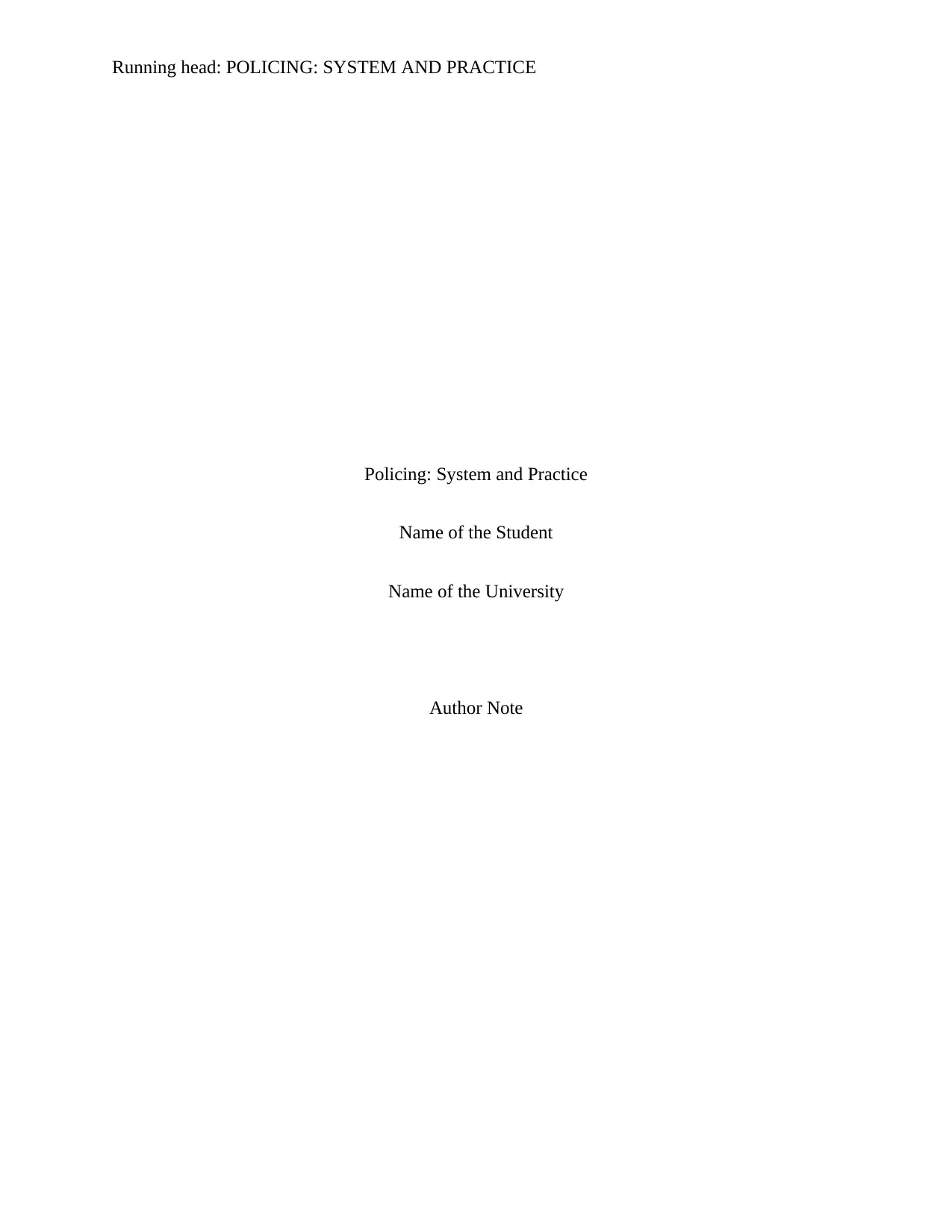
Running head: POLICING: SYSTEM AND PRACTICE
Policing: System and Practice
Name of the Student
Name of the University
Author Note
Policing: System and Practice
Name of the Student
Name of the University
Author Note
Paraphrase This Document
Need a fresh take? Get an instant paraphrase of this document with our AI Paraphraser
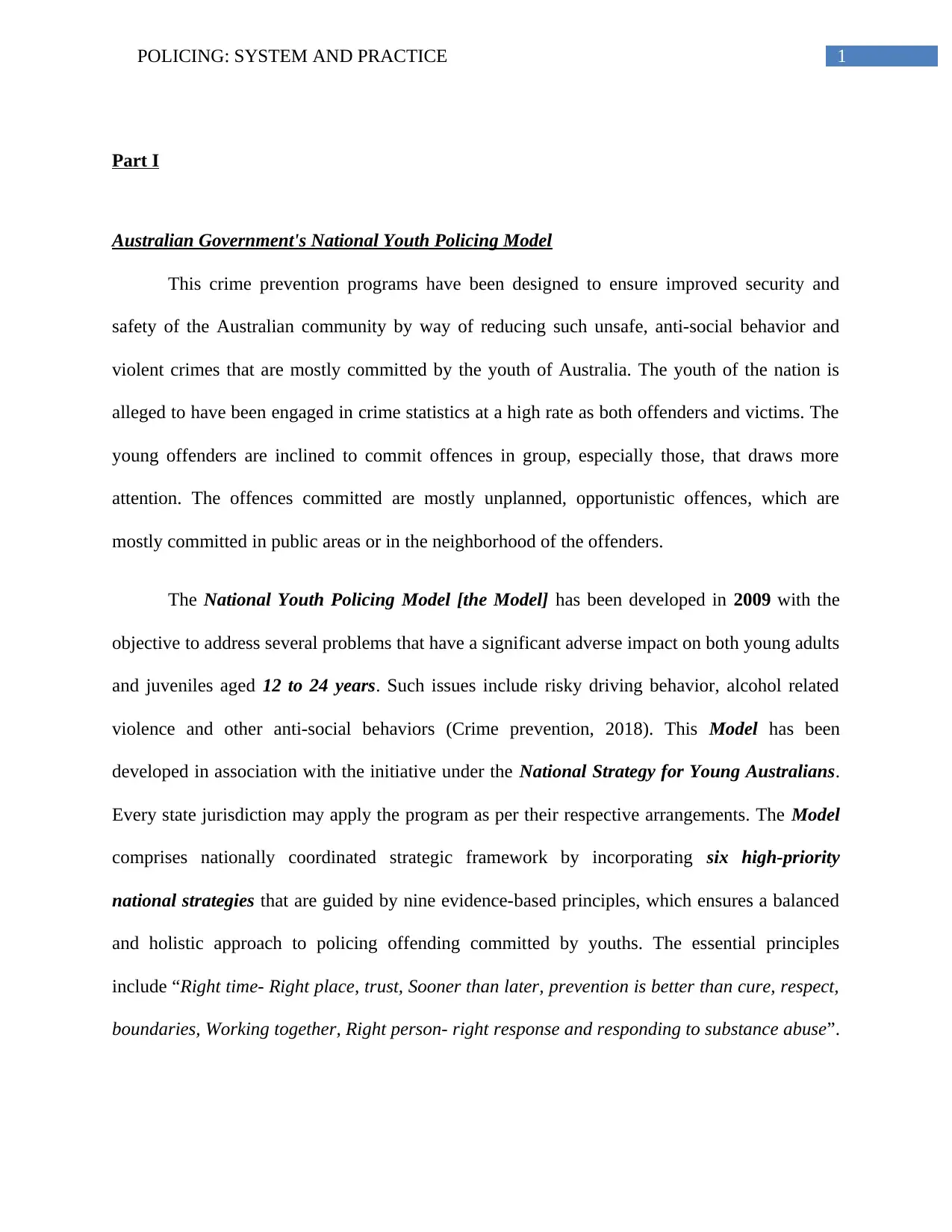
1POLICING: SYSTEM AND PRACTICE
Part I
Australian Government's National Youth Policing Model
This crime prevention programs have been designed to ensure improved security and
safety of the Australian community by way of reducing such unsafe, anti-social behavior and
violent crimes that are mostly committed by the youth of Australia. The youth of the nation is
alleged to have been engaged in crime statistics at a high rate as both offenders and victims. The
young offenders are inclined to commit offences in group, especially those, that draws more
attention. The offences committed are mostly unplanned, opportunistic offences, which are
mostly committed in public areas or in the neighborhood of the offenders.
The National Youth Policing Model [the Model] has been developed in 2009 with the
objective to address several problems that have a significant adverse impact on both young adults
and juveniles aged 12 to 24 years. Such issues include risky driving behavior, alcohol related
violence and other anti-social behaviors (Crime prevention, 2018). This Model has been
developed in association with the initiative under the National Strategy for Young Australians.
Every state jurisdiction may apply the program as per their respective arrangements. The Model
comprises nationally coordinated strategic framework by incorporating six high-priority
national strategies that are guided by nine evidence-based principles, which ensures a balanced
and holistic approach to policing offending committed by youths. The essential principles
include “Right time- Right place, trust, Sooner than later, prevention is better than cure, respect,
boundaries, Working together, Right person- right response and responding to substance abuse”.
Part I
Australian Government's National Youth Policing Model
This crime prevention programs have been designed to ensure improved security and
safety of the Australian community by way of reducing such unsafe, anti-social behavior and
violent crimes that are mostly committed by the youth of Australia. The youth of the nation is
alleged to have been engaged in crime statistics at a high rate as both offenders and victims. The
young offenders are inclined to commit offences in group, especially those, that draws more
attention. The offences committed are mostly unplanned, opportunistic offences, which are
mostly committed in public areas or in the neighborhood of the offenders.
The National Youth Policing Model [the Model] has been developed in 2009 with the
objective to address several problems that have a significant adverse impact on both young adults
and juveniles aged 12 to 24 years. Such issues include risky driving behavior, alcohol related
violence and other anti-social behaviors (Crime prevention, 2018). This Model has been
developed in association with the initiative under the National Strategy for Young Australians.
Every state jurisdiction may apply the program as per their respective arrangements. The Model
comprises nationally coordinated strategic framework by incorporating six high-priority
national strategies that are guided by nine evidence-based principles, which ensures a balanced
and holistic approach to policing offending committed by youths. The essential principles
include “Right time- Right place, trust, Sooner than later, prevention is better than cure, respect,
boundaries, Working together, Right person- right response and responding to substance abuse”.
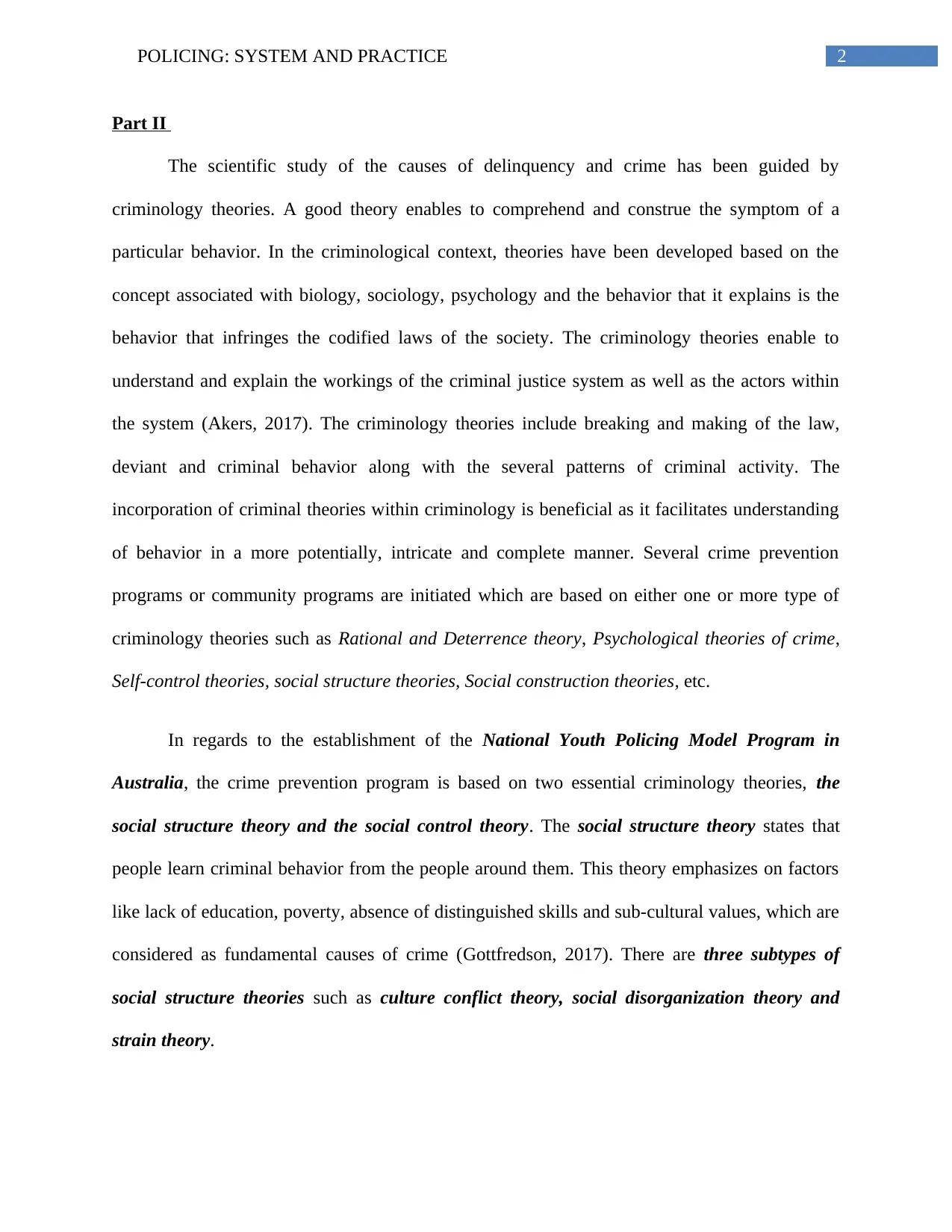
2POLICING: SYSTEM AND PRACTICE
Part II
The scientific study of the causes of delinquency and crime has been guided by
criminology theories. A good theory enables to comprehend and construe the symptom of a
particular behavior. In the criminological context, theories have been developed based on the
concept associated with biology, sociology, psychology and the behavior that it explains is the
behavior that infringes the codified laws of the society. The criminology theories enable to
understand and explain the workings of the criminal justice system as well as the actors within
the system (Akers, 2017). The criminology theories include breaking and making of the law,
deviant and criminal behavior along with the several patterns of criminal activity. The
incorporation of criminal theories within criminology is beneficial as it facilitates understanding
of behavior in a more potentially, intricate and complete manner. Several crime prevention
programs or community programs are initiated which are based on either one or more type of
criminology theories such as Rational and Deterrence theory, Psychological theories of crime,
Self-control theories, social structure theories, Social construction theories, etc.
In regards to the establishment of the National Youth Policing Model Program in
Australia, the crime prevention program is based on two essential criminology theories, the
social structure theory and the social control theory. The social structure theory states that
people learn criminal behavior from the people around them. This theory emphasizes on factors
like lack of education, poverty, absence of distinguished skills and sub-cultural values, which are
considered as fundamental causes of crime (Gottfredson, 2017). There are three subtypes of
social structure theories such as culture conflict theory, social disorganization theory and
strain theory.
Part II
The scientific study of the causes of delinquency and crime has been guided by
criminology theories. A good theory enables to comprehend and construe the symptom of a
particular behavior. In the criminological context, theories have been developed based on the
concept associated with biology, sociology, psychology and the behavior that it explains is the
behavior that infringes the codified laws of the society. The criminology theories enable to
understand and explain the workings of the criminal justice system as well as the actors within
the system (Akers, 2017). The criminology theories include breaking and making of the law,
deviant and criminal behavior along with the several patterns of criminal activity. The
incorporation of criminal theories within criminology is beneficial as it facilitates understanding
of behavior in a more potentially, intricate and complete manner. Several crime prevention
programs or community programs are initiated which are based on either one or more type of
criminology theories such as Rational and Deterrence theory, Psychological theories of crime,
Self-control theories, social structure theories, Social construction theories, etc.
In regards to the establishment of the National Youth Policing Model Program in
Australia, the crime prevention program is based on two essential criminology theories, the
social structure theory and the social control theory. The social structure theory states that
people learn criminal behavior from the people around them. This theory emphasizes on factors
like lack of education, poverty, absence of distinguished skills and sub-cultural values, which are
considered as fundamental causes of crime (Gottfredson, 2017). There are three subtypes of
social structure theories such as culture conflict theory, social disorganization theory and
strain theory.
⊘ This is a preview!⊘
Do you want full access?
Subscribe today to unlock all pages.

Trusted by 1+ million students worldwide
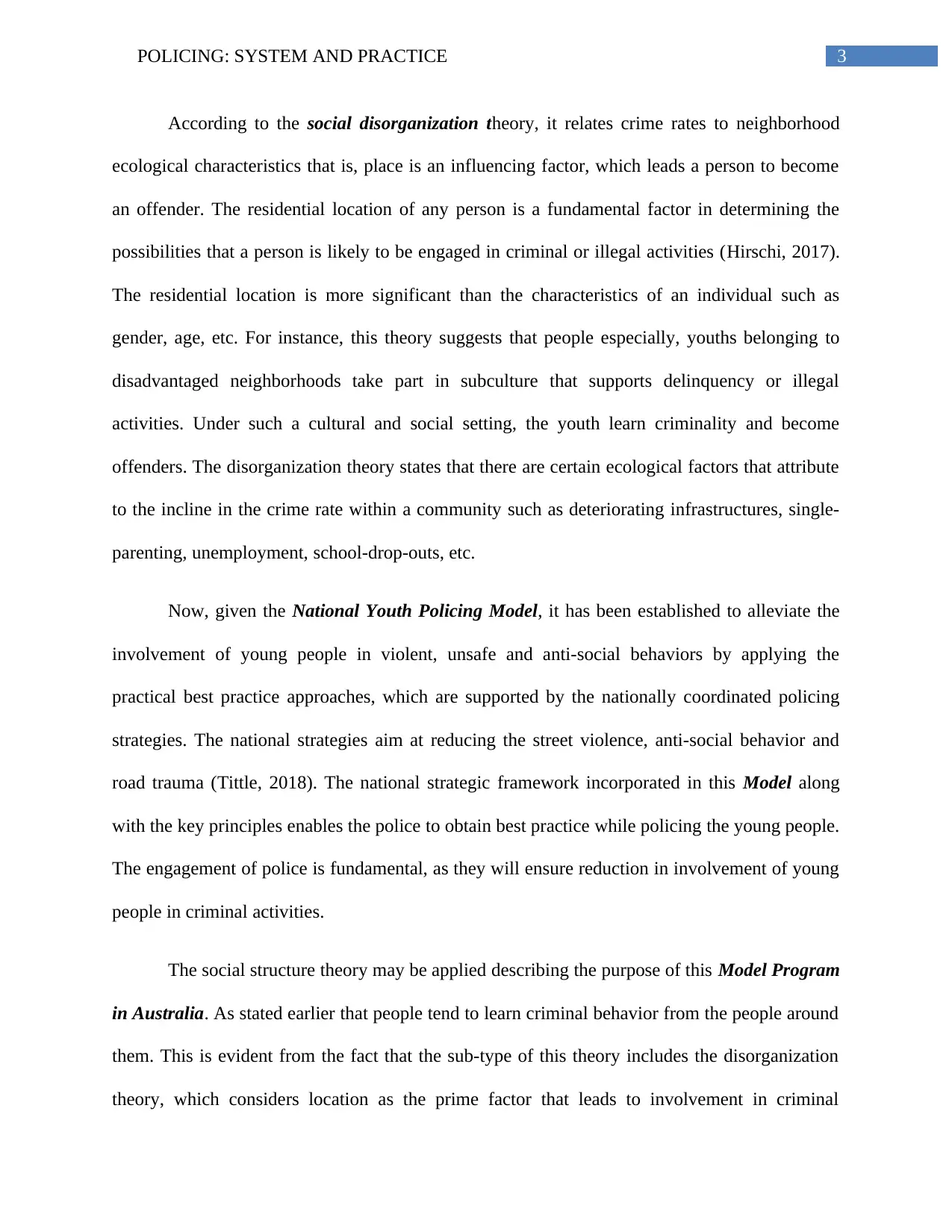
3POLICING: SYSTEM AND PRACTICE
According to the social disorganization theory, it relates crime rates to neighborhood
ecological characteristics that is, place is an influencing factor, which leads a person to become
an offender. The residential location of any person is a fundamental factor in determining the
possibilities that a person is likely to be engaged in criminal or illegal activities (Hirschi, 2017).
The residential location is more significant than the characteristics of an individual such as
gender, age, etc. For instance, this theory suggests that people especially, youths belonging to
disadvantaged neighborhoods take part in subculture that supports delinquency or illegal
activities. Under such a cultural and social setting, the youth learn criminality and become
offenders. The disorganization theory states that there are certain ecological factors that attribute
to the incline in the crime rate within a community such as deteriorating infrastructures, single-
parenting, unemployment, school-drop-outs, etc.
Now, given the National Youth Policing Model, it has been established to alleviate the
involvement of young people in violent, unsafe and anti-social behaviors by applying the
practical best practice approaches, which are supported by the nationally coordinated policing
strategies. The national strategies aim at reducing the street violence, anti-social behavior and
road trauma (Tittle, 2018). The national strategic framework incorporated in this Model along
with the key principles enables the police to obtain best practice while policing the young people.
The engagement of police is fundamental, as they will ensure reduction in involvement of young
people in criminal activities.
The social structure theory may be applied describing the purpose of this Model Program
in Australia. As stated earlier that people tend to learn criminal behavior from the people around
them. This is evident from the fact that the sub-type of this theory includes the disorganization
theory, which considers location as the prime factor that leads to involvement in criminal
According to the social disorganization theory, it relates crime rates to neighborhood
ecological characteristics that is, place is an influencing factor, which leads a person to become
an offender. The residential location of any person is a fundamental factor in determining the
possibilities that a person is likely to be engaged in criminal or illegal activities (Hirschi, 2017).
The residential location is more significant than the characteristics of an individual such as
gender, age, etc. For instance, this theory suggests that people especially, youths belonging to
disadvantaged neighborhoods take part in subculture that supports delinquency or illegal
activities. Under such a cultural and social setting, the youth learn criminality and become
offenders. The disorganization theory states that there are certain ecological factors that attribute
to the incline in the crime rate within a community such as deteriorating infrastructures, single-
parenting, unemployment, school-drop-outs, etc.
Now, given the National Youth Policing Model, it has been established to alleviate the
involvement of young people in violent, unsafe and anti-social behaviors by applying the
practical best practice approaches, which are supported by the nationally coordinated policing
strategies. The national strategies aim at reducing the street violence, anti-social behavior and
road trauma (Tittle, 2018). The national strategic framework incorporated in this Model along
with the key principles enables the police to obtain best practice while policing the young people.
The engagement of police is fundamental, as they will ensure reduction in involvement of young
people in criminal activities.
The social structure theory may be applied describing the purpose of this Model Program
in Australia. As stated earlier that people tend to learn criminal behavior from the people around
them. This is evident from the fact that the sub-type of this theory includes the disorganization
theory, which considers location as the prime factor that leads to involvement in criminal
Paraphrase This Document
Need a fresh take? Get an instant paraphrase of this document with our AI Paraphraser
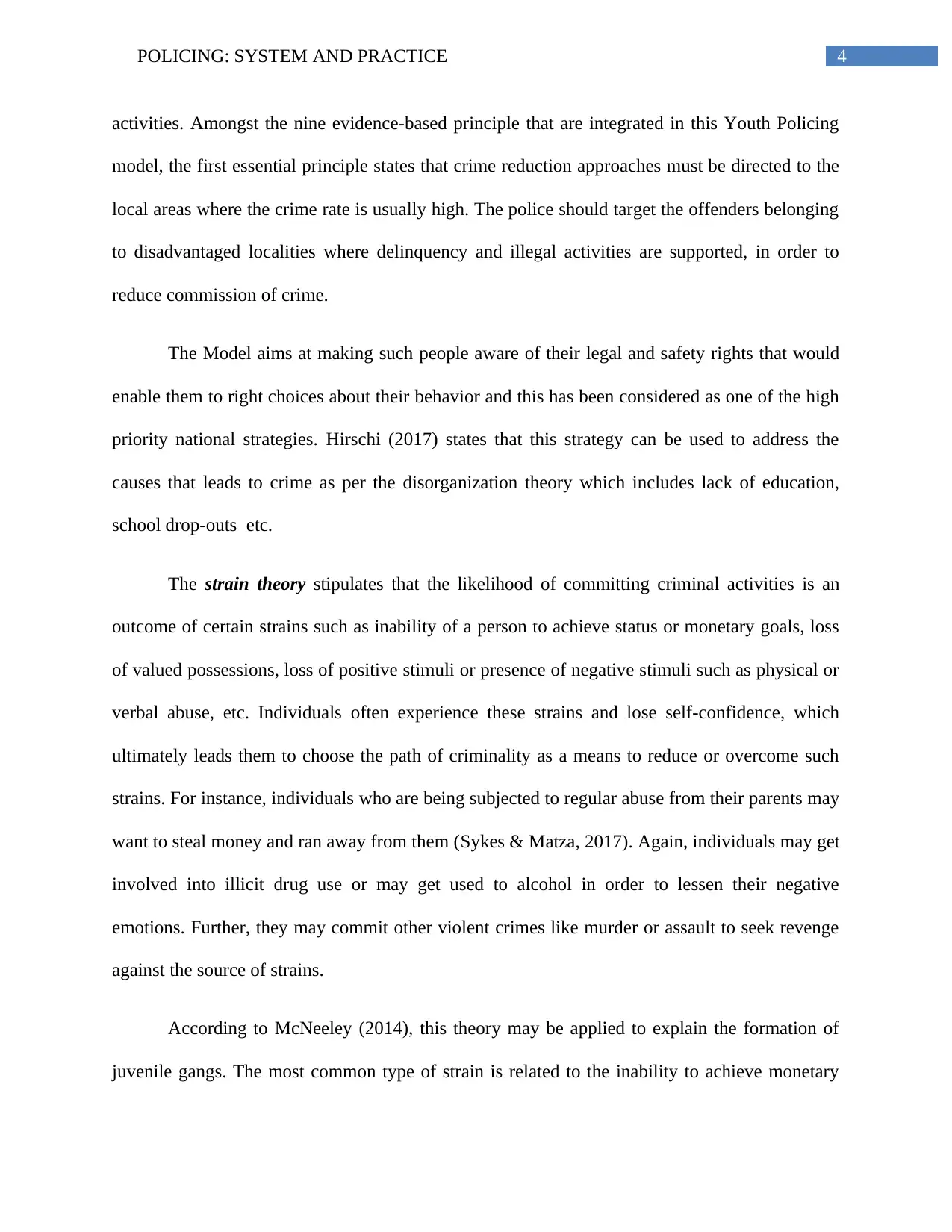
4POLICING: SYSTEM AND PRACTICE
activities. Amongst the nine evidence-based principle that are integrated in this Youth Policing
model, the first essential principle states that crime reduction approaches must be directed to the
local areas where the crime rate is usually high. The police should target the offenders belonging
to disadvantaged localities where delinquency and illegal activities are supported, in order to
reduce commission of crime.
The Model aims at making such people aware of their legal and safety rights that would
enable them to right choices about their behavior and this has been considered as one of the high
priority national strategies. Hirschi (2017) states that this strategy can be used to address the
causes that leads to crime as per the disorganization theory which includes lack of education,
school drop-outs etc.
The strain theory stipulates that the likelihood of committing criminal activities is an
outcome of certain strains such as inability of a person to achieve status or monetary goals, loss
of valued possessions, loss of positive stimuli or presence of negative stimuli such as physical or
verbal abuse, etc. Individuals often experience these strains and lose self-confidence, which
ultimately leads them to choose the path of criminality as a means to reduce or overcome such
strains. For instance, individuals who are being subjected to regular abuse from their parents may
want to steal money and ran away from them (Sykes & Matza, 2017). Again, individuals may get
involved into illicit drug use or may get used to alcohol in order to lessen their negative
emotions. Further, they may commit other violent crimes like murder or assault to seek revenge
against the source of strains.
According to McNeeley (2014), this theory may be applied to explain the formation of
juvenile gangs. The most common type of strain is related to the inability to achieve monetary
activities. Amongst the nine evidence-based principle that are integrated in this Youth Policing
model, the first essential principle states that crime reduction approaches must be directed to the
local areas where the crime rate is usually high. The police should target the offenders belonging
to disadvantaged localities where delinquency and illegal activities are supported, in order to
reduce commission of crime.
The Model aims at making such people aware of their legal and safety rights that would
enable them to right choices about their behavior and this has been considered as one of the high
priority national strategies. Hirschi (2017) states that this strategy can be used to address the
causes that leads to crime as per the disorganization theory which includes lack of education,
school drop-outs etc.
The strain theory stipulates that the likelihood of committing criminal activities is an
outcome of certain strains such as inability of a person to achieve status or monetary goals, loss
of valued possessions, loss of positive stimuli or presence of negative stimuli such as physical or
verbal abuse, etc. Individuals often experience these strains and lose self-confidence, which
ultimately leads them to choose the path of criminality as a means to reduce or overcome such
strains. For instance, individuals who are being subjected to regular abuse from their parents may
want to steal money and ran away from them (Sykes & Matza, 2017). Again, individuals may get
involved into illicit drug use or may get used to alcohol in order to lessen their negative
emotions. Further, they may commit other violent crimes like murder or assault to seek revenge
against the source of strains.
According to McNeeley (2014), this theory may be applied to explain the formation of
juvenile gangs. The most common type of strain is related to the inability to achieve monetary
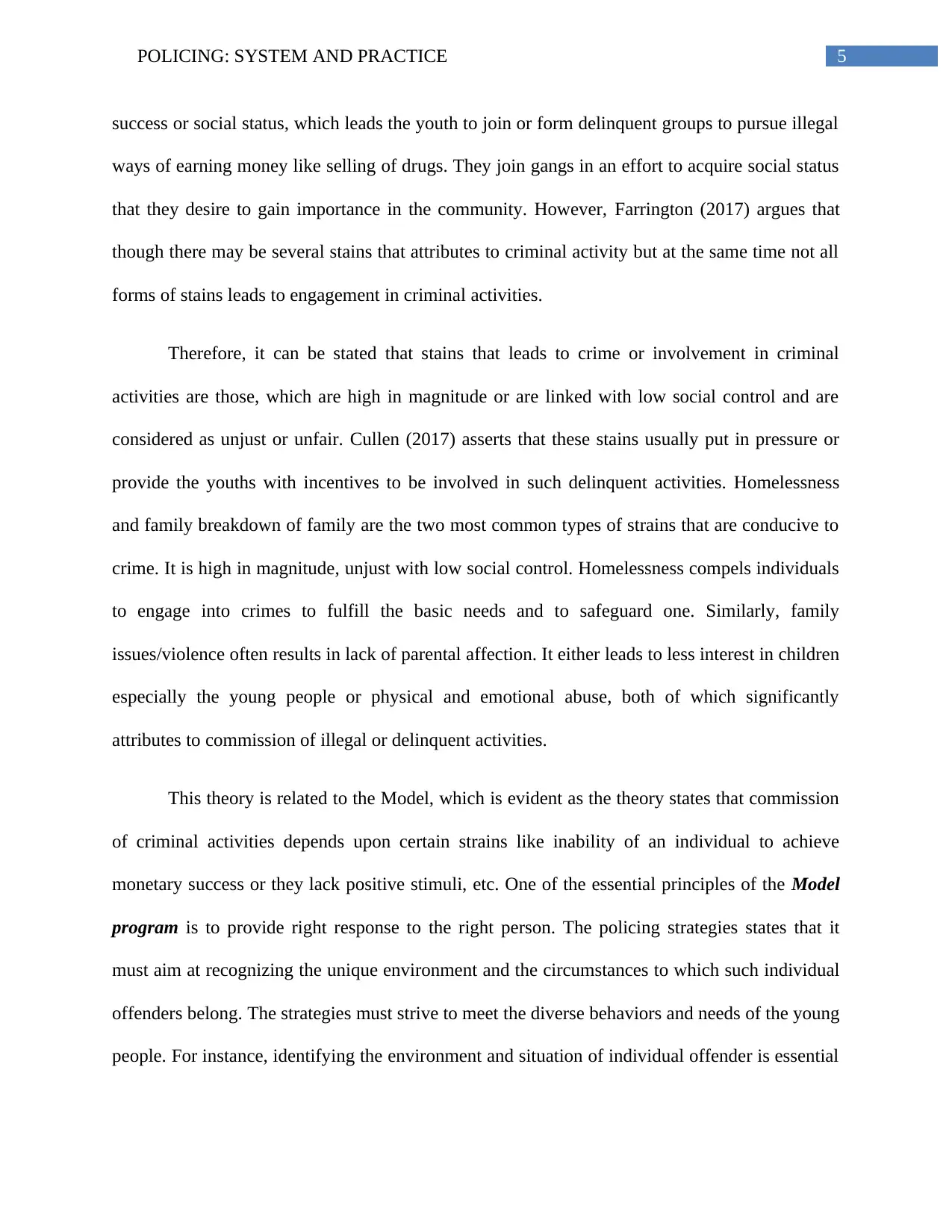
5POLICING: SYSTEM AND PRACTICE
success or social status, which leads the youth to join or form delinquent groups to pursue illegal
ways of earning money like selling of drugs. They join gangs in an effort to acquire social status
that they desire to gain importance in the community. However, Farrington (2017) argues that
though there may be several stains that attributes to criminal activity but at the same time not all
forms of stains leads to engagement in criminal activities.
Therefore, it can be stated that stains that leads to crime or involvement in criminal
activities are those, which are high in magnitude or are linked with low social control and are
considered as unjust or unfair. Cullen (2017) asserts that these stains usually put in pressure or
provide the youths with incentives to be involved in such delinquent activities. Homelessness
and family breakdown of family are the two most common types of strains that are conducive to
crime. It is high in magnitude, unjust with low social control. Homelessness compels individuals
to engage into crimes to fulfill the basic needs and to safeguard one. Similarly, family
issues/violence often results in lack of parental affection. It either leads to less interest in children
especially the young people or physical and emotional abuse, both of which significantly
attributes to commission of illegal or delinquent activities.
This theory is related to the Model, which is evident as the theory states that commission
of criminal activities depends upon certain strains like inability of an individual to achieve
monetary success or they lack positive stimuli, etc. One of the essential principles of the Model
program is to provide right response to the right person. The policing strategies states that it
must aim at recognizing the unique environment and the circumstances to which such individual
offenders belong. The strategies must strive to meet the diverse behaviors and needs of the young
people. For instance, identifying the environment and situation of individual offender is essential
success or social status, which leads the youth to join or form delinquent groups to pursue illegal
ways of earning money like selling of drugs. They join gangs in an effort to acquire social status
that they desire to gain importance in the community. However, Farrington (2017) argues that
though there may be several stains that attributes to criminal activity but at the same time not all
forms of stains leads to engagement in criminal activities.
Therefore, it can be stated that stains that leads to crime or involvement in criminal
activities are those, which are high in magnitude or are linked with low social control and are
considered as unjust or unfair. Cullen (2017) asserts that these stains usually put in pressure or
provide the youths with incentives to be involved in such delinquent activities. Homelessness
and family breakdown of family are the two most common types of strains that are conducive to
crime. It is high in magnitude, unjust with low social control. Homelessness compels individuals
to engage into crimes to fulfill the basic needs and to safeguard one. Similarly, family
issues/violence often results in lack of parental affection. It either leads to less interest in children
especially the young people or physical and emotional abuse, both of which significantly
attributes to commission of illegal or delinquent activities.
This theory is related to the Model, which is evident as the theory states that commission
of criminal activities depends upon certain strains like inability of an individual to achieve
monetary success or they lack positive stimuli, etc. One of the essential principles of the Model
program is to provide right response to the right person. The policing strategies states that it
must aim at recognizing the unique environment and the circumstances to which such individual
offenders belong. The strategies must strive to meet the diverse behaviors and needs of the young
people. For instance, identifying the environment and situation of individual offender is essential
⊘ This is a preview!⊘
Do you want full access?
Subscribe today to unlock all pages.

Trusted by 1+ million students worldwide
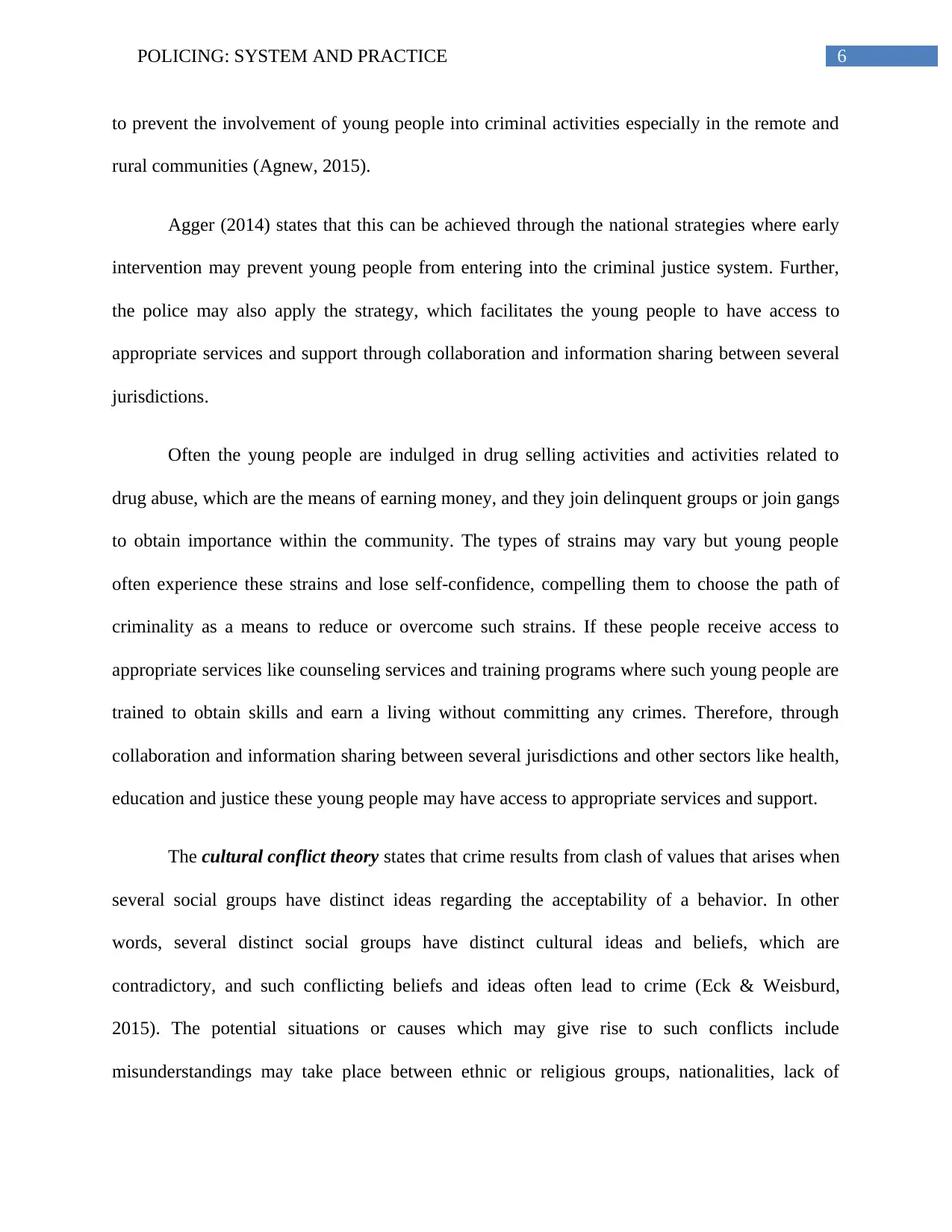
6POLICING: SYSTEM AND PRACTICE
to prevent the involvement of young people into criminal activities especially in the remote and
rural communities (Agnew, 2015).
Agger (2014) states that this can be achieved through the national strategies where early
intervention may prevent young people from entering into the criminal justice system. Further,
the police may also apply the strategy, which facilitates the young people to have access to
appropriate services and support through collaboration and information sharing between several
jurisdictions.
Often the young people are indulged in drug selling activities and activities related to
drug abuse, which are the means of earning money, and they join delinquent groups or join gangs
to obtain importance within the community. The types of strains may vary but young people
often experience these strains and lose self-confidence, compelling them to choose the path of
criminality as a means to reduce or overcome such strains. If these people receive access to
appropriate services like counseling services and training programs where such young people are
trained to obtain skills and earn a living without committing any crimes. Therefore, through
collaboration and information sharing between several jurisdictions and other sectors like health,
education and justice these young people may have access to appropriate services and support.
The cultural conflict theory states that crime results from clash of values that arises when
several social groups have distinct ideas regarding the acceptability of a behavior. In other
words, several distinct social groups have distinct cultural ideas and beliefs, which are
contradictory, and such conflicting beliefs and ideas often lead to crime (Eck & Weisburd,
2015). The potential situations or causes which may give rise to such conflicts include
misunderstandings may take place between ethnic or religious groups, nationalities, lack of
to prevent the involvement of young people into criminal activities especially in the remote and
rural communities (Agnew, 2015).
Agger (2014) states that this can be achieved through the national strategies where early
intervention may prevent young people from entering into the criminal justice system. Further,
the police may also apply the strategy, which facilitates the young people to have access to
appropriate services and support through collaboration and information sharing between several
jurisdictions.
Often the young people are indulged in drug selling activities and activities related to
drug abuse, which are the means of earning money, and they join delinquent groups or join gangs
to obtain importance within the community. The types of strains may vary but young people
often experience these strains and lose self-confidence, compelling them to choose the path of
criminality as a means to reduce or overcome such strains. If these people receive access to
appropriate services like counseling services and training programs where such young people are
trained to obtain skills and earn a living without committing any crimes. Therefore, through
collaboration and information sharing between several jurisdictions and other sectors like health,
education and justice these young people may have access to appropriate services and support.
The cultural conflict theory states that crime results from clash of values that arises when
several social groups have distinct ideas regarding the acceptability of a behavior. In other
words, several distinct social groups have distinct cultural ideas and beliefs, which are
contradictory, and such conflicting beliefs and ideas often lead to crime (Eck & Weisburd,
2015). The potential situations or causes which may give rise to such conflicts include
misunderstandings may take place between ethnic or religious groups, nationalities, lack of
Paraphrase This Document
Need a fresh take? Get an instant paraphrase of this document with our AI Paraphraser
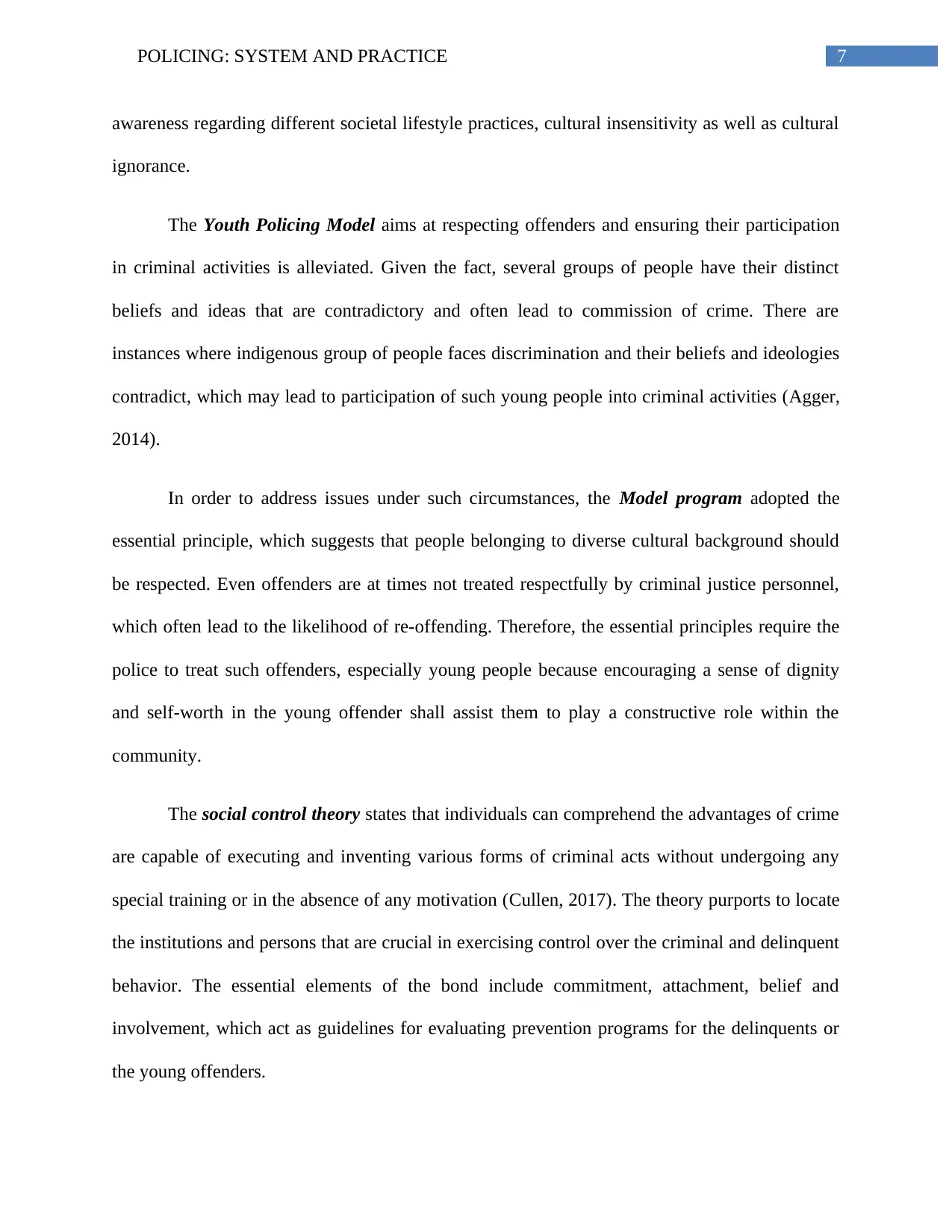
7POLICING: SYSTEM AND PRACTICE
awareness regarding different societal lifestyle practices, cultural insensitivity as well as cultural
ignorance.
The Youth Policing Model aims at respecting offenders and ensuring their participation
in criminal activities is alleviated. Given the fact, several groups of people have their distinct
beliefs and ideas that are contradictory and often lead to commission of crime. There are
instances where indigenous group of people faces discrimination and their beliefs and ideologies
contradict, which may lead to participation of such young people into criminal activities (Agger,
2014).
In order to address issues under such circumstances, the Model program adopted the
essential principle, which suggests that people belonging to diverse cultural background should
be respected. Even offenders are at times not treated respectfully by criminal justice personnel,
which often lead to the likelihood of re-offending. Therefore, the essential principles require the
police to treat such offenders, especially young people because encouraging a sense of dignity
and self-worth in the young offender shall assist them to play a constructive role within the
community.
The social control theory states that individuals can comprehend the advantages of crime
are capable of executing and inventing various forms of criminal acts without undergoing any
special training or in the absence of any motivation (Cullen, 2017). The theory purports to locate
the institutions and persons that are crucial in exercising control over the criminal and delinquent
behavior. The essential elements of the bond include commitment, attachment, belief and
involvement, which act as guidelines for evaluating prevention programs for the delinquents or
the young offenders.
awareness regarding different societal lifestyle practices, cultural insensitivity as well as cultural
ignorance.
The Youth Policing Model aims at respecting offenders and ensuring their participation
in criminal activities is alleviated. Given the fact, several groups of people have their distinct
beliefs and ideas that are contradictory and often lead to commission of crime. There are
instances where indigenous group of people faces discrimination and their beliefs and ideologies
contradict, which may lead to participation of such young people into criminal activities (Agger,
2014).
In order to address issues under such circumstances, the Model program adopted the
essential principle, which suggests that people belonging to diverse cultural background should
be respected. Even offenders are at times not treated respectfully by criminal justice personnel,
which often lead to the likelihood of re-offending. Therefore, the essential principles require the
police to treat such offenders, especially young people because encouraging a sense of dignity
and self-worth in the young offender shall assist them to play a constructive role within the
community.
The social control theory states that individuals can comprehend the advantages of crime
are capable of executing and inventing various forms of criminal acts without undergoing any
special training or in the absence of any motivation (Cullen, 2017). The theory purports to locate
the institutions and persons that are crucial in exercising control over the criminal and delinquent
behavior. The essential elements of the bond include commitment, attachment, belief and
involvement, which act as guidelines for evaluating prevention programs for the delinquents or
the young offenders.
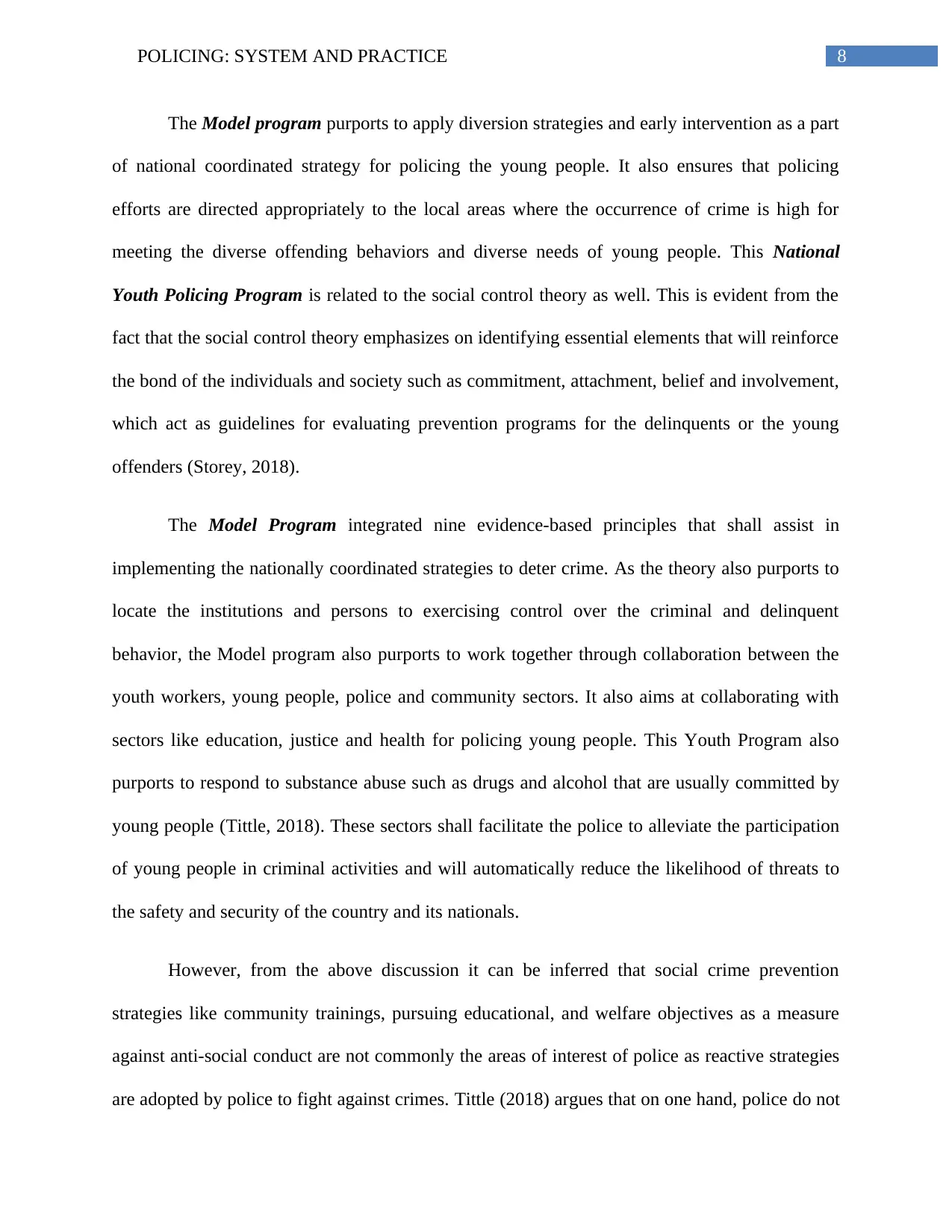
8POLICING: SYSTEM AND PRACTICE
The Model program purports to apply diversion strategies and early intervention as a part
of national coordinated strategy for policing the young people. It also ensures that policing
efforts are directed appropriately to the local areas where the occurrence of crime is high for
meeting the diverse offending behaviors and diverse needs of young people. This National
Youth Policing Program is related to the social control theory as well. This is evident from the
fact that the social control theory emphasizes on identifying essential elements that will reinforce
the bond of the individuals and society such as commitment, attachment, belief and involvement,
which act as guidelines for evaluating prevention programs for the delinquents or the young
offenders (Storey, 2018).
The Model Program integrated nine evidence-based principles that shall assist in
implementing the nationally coordinated strategies to deter crime. As the theory also purports to
locate the institutions and persons to exercising control over the criminal and delinquent
behavior, the Model program also purports to work together through collaboration between the
youth workers, young people, police and community sectors. It also aims at collaborating with
sectors like education, justice and health for policing young people. This Youth Program also
purports to respond to substance abuse such as drugs and alcohol that are usually committed by
young people (Tittle, 2018). These sectors shall facilitate the police to alleviate the participation
of young people in criminal activities and will automatically reduce the likelihood of threats to
the safety and security of the country and its nationals.
However, from the above discussion it can be inferred that social crime prevention
strategies like community trainings, pursuing educational, and welfare objectives as a measure
against anti-social conduct are not commonly the areas of interest of police as reactive strategies
are adopted by police to fight against crimes. Tittle (2018) argues that on one hand, police do not
The Model program purports to apply diversion strategies and early intervention as a part
of national coordinated strategy for policing the young people. It also ensures that policing
efforts are directed appropriately to the local areas where the occurrence of crime is high for
meeting the diverse offending behaviors and diverse needs of young people. This National
Youth Policing Program is related to the social control theory as well. This is evident from the
fact that the social control theory emphasizes on identifying essential elements that will reinforce
the bond of the individuals and society such as commitment, attachment, belief and involvement,
which act as guidelines for evaluating prevention programs for the delinquents or the young
offenders (Storey, 2018).
The Model Program integrated nine evidence-based principles that shall assist in
implementing the nationally coordinated strategies to deter crime. As the theory also purports to
locate the institutions and persons to exercising control over the criminal and delinquent
behavior, the Model program also purports to work together through collaboration between the
youth workers, young people, police and community sectors. It also aims at collaborating with
sectors like education, justice and health for policing young people. This Youth Program also
purports to respond to substance abuse such as drugs and alcohol that are usually committed by
young people (Tittle, 2018). These sectors shall facilitate the police to alleviate the participation
of young people in criminal activities and will automatically reduce the likelihood of threats to
the safety and security of the country and its nationals.
However, from the above discussion it can be inferred that social crime prevention
strategies like community trainings, pursuing educational, and welfare objectives as a measure
against anti-social conduct are not commonly the areas of interest of police as reactive strategies
are adopted by police to fight against crimes. Tittle (2018) argues that on one hand, police do not
⊘ This is a preview!⊘
Do you want full access?
Subscribe today to unlock all pages.

Trusted by 1+ million students worldwide
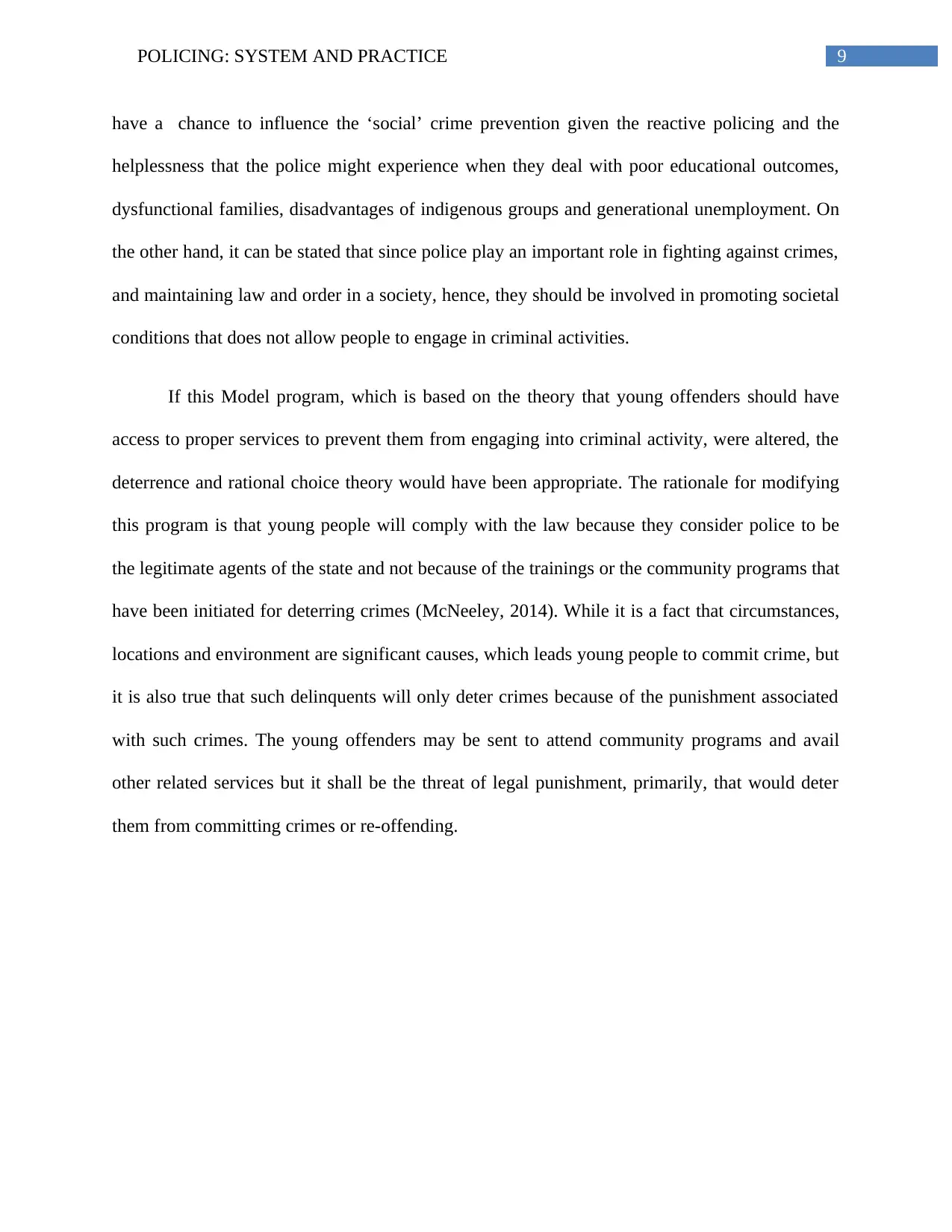
9POLICING: SYSTEM AND PRACTICE
have a chance to influence the ‘social’ crime prevention given the reactive policing and the
helplessness that the police might experience when they deal with poor educational outcomes,
dysfunctional families, disadvantages of indigenous groups and generational unemployment. On
the other hand, it can be stated that since police play an important role in fighting against crimes,
and maintaining law and order in a society, hence, they should be involved in promoting societal
conditions that does not allow people to engage in criminal activities.
If this Model program, which is based on the theory that young offenders should have
access to proper services to prevent them from engaging into criminal activity, were altered, the
deterrence and rational choice theory would have been appropriate. The rationale for modifying
this program is that young people will comply with the law because they consider police to be
the legitimate agents of the state and not because of the trainings or the community programs that
have been initiated for deterring crimes (McNeeley, 2014). While it is a fact that circumstances,
locations and environment are significant causes, which leads young people to commit crime, but
it is also true that such delinquents will only deter crimes because of the punishment associated
with such crimes. The young offenders may be sent to attend community programs and avail
other related services but it shall be the threat of legal punishment, primarily, that would deter
them from committing crimes or re-offending.
have a chance to influence the ‘social’ crime prevention given the reactive policing and the
helplessness that the police might experience when they deal with poor educational outcomes,
dysfunctional families, disadvantages of indigenous groups and generational unemployment. On
the other hand, it can be stated that since police play an important role in fighting against crimes,
and maintaining law and order in a society, hence, they should be involved in promoting societal
conditions that does not allow people to engage in criminal activities.
If this Model program, which is based on the theory that young offenders should have
access to proper services to prevent them from engaging into criminal activity, were altered, the
deterrence and rational choice theory would have been appropriate. The rationale for modifying
this program is that young people will comply with the law because they consider police to be
the legitimate agents of the state and not because of the trainings or the community programs that
have been initiated for deterring crimes (McNeeley, 2014). While it is a fact that circumstances,
locations and environment are significant causes, which leads young people to commit crime, but
it is also true that such delinquents will only deter crimes because of the punishment associated
with such crimes. The young offenders may be sent to attend community programs and avail
other related services but it shall be the threat of legal punishment, primarily, that would deter
them from committing crimes or re-offending.
Paraphrase This Document
Need a fresh take? Get an instant paraphrase of this document with our AI Paraphraser
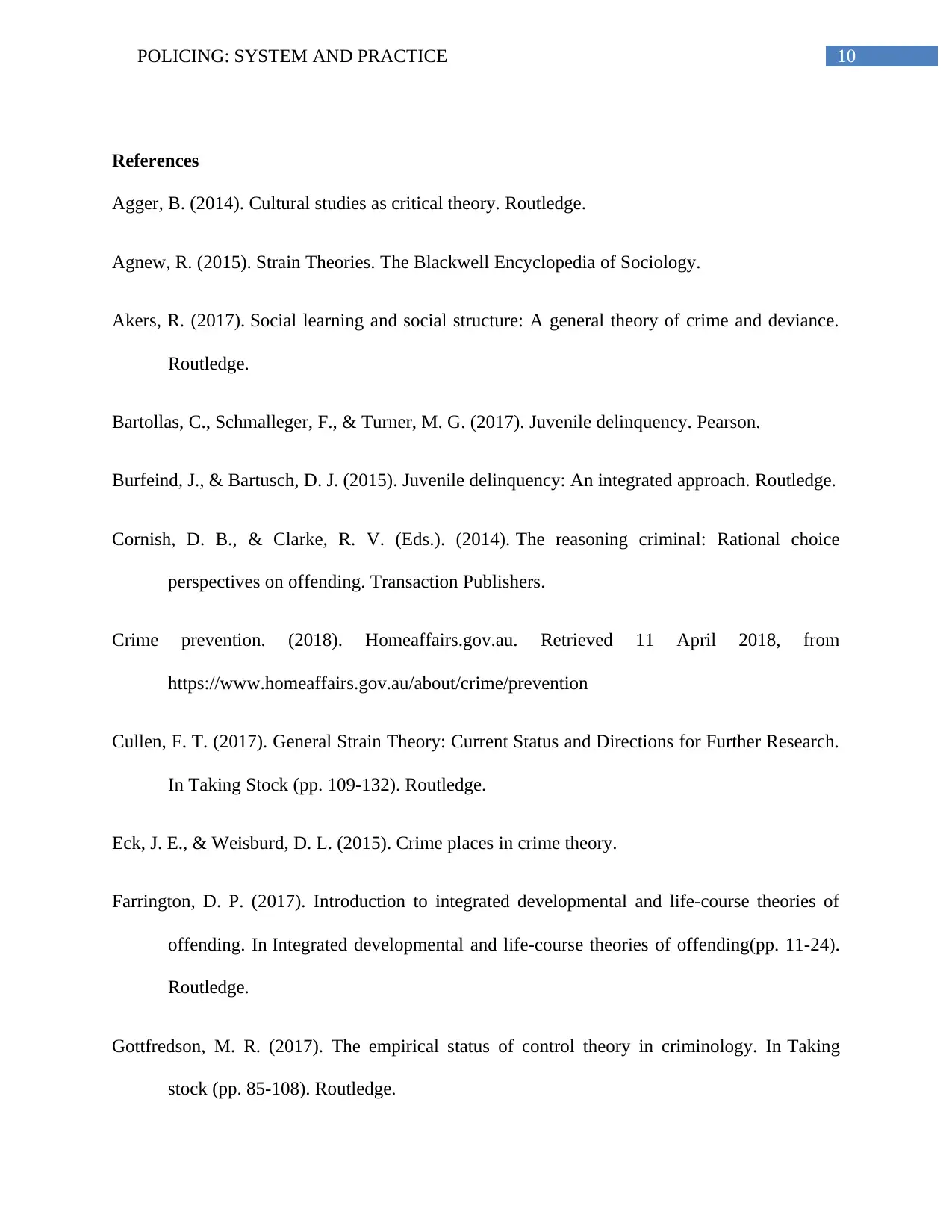
10POLICING: SYSTEM AND PRACTICE
References
Agger, B. (2014). Cultural studies as critical theory. Routledge.
Agnew, R. (2015). Strain Theories. The Blackwell Encyclopedia of Sociology.
Akers, R. (2017). Social learning and social structure: A general theory of crime and deviance.
Routledge.
Bartollas, C., Schmalleger, F., & Turner, M. G. (2017). Juvenile delinquency. Pearson.
Burfeind, J., & Bartusch, D. J. (2015). Juvenile delinquency: An integrated approach. Routledge.
Cornish, D. B., & Clarke, R. V. (Eds.). (2014). The reasoning criminal: Rational choice
perspectives on offending. Transaction Publishers.
Crime prevention. (2018). Homeaffairs.gov.au. Retrieved 11 April 2018, from
https://www.homeaffairs.gov.au/about/crime/prevention
Cullen, F. T. (2017). General Strain Theory: Current Status and Directions for Further Research.
In Taking Stock (pp. 109-132). Routledge.
Eck, J. E., & Weisburd, D. L. (2015). Crime places in crime theory.
Farrington, D. P. (2017). Introduction to integrated developmental and life-course theories of
offending. In Integrated developmental and life-course theories of offending(pp. 11-24).
Routledge.
Gottfredson, M. R. (2017). The empirical status of control theory in criminology. In Taking
stock (pp. 85-108). Routledge.
References
Agger, B. (2014). Cultural studies as critical theory. Routledge.
Agnew, R. (2015). Strain Theories. The Blackwell Encyclopedia of Sociology.
Akers, R. (2017). Social learning and social structure: A general theory of crime and deviance.
Routledge.
Bartollas, C., Schmalleger, F., & Turner, M. G. (2017). Juvenile delinquency. Pearson.
Burfeind, J., & Bartusch, D. J. (2015). Juvenile delinquency: An integrated approach. Routledge.
Cornish, D. B., & Clarke, R. V. (Eds.). (2014). The reasoning criminal: Rational choice
perspectives on offending. Transaction Publishers.
Crime prevention. (2018). Homeaffairs.gov.au. Retrieved 11 April 2018, from
https://www.homeaffairs.gov.au/about/crime/prevention
Cullen, F. T. (2017). General Strain Theory: Current Status and Directions for Further Research.
In Taking Stock (pp. 109-132). Routledge.
Eck, J. E., & Weisburd, D. L. (2015). Crime places in crime theory.
Farrington, D. P. (2017). Introduction to integrated developmental and life-course theories of
offending. In Integrated developmental and life-course theories of offending(pp. 11-24).
Routledge.
Gottfredson, M. R. (2017). The empirical status of control theory in criminology. In Taking
stock (pp. 85-108). Routledge.
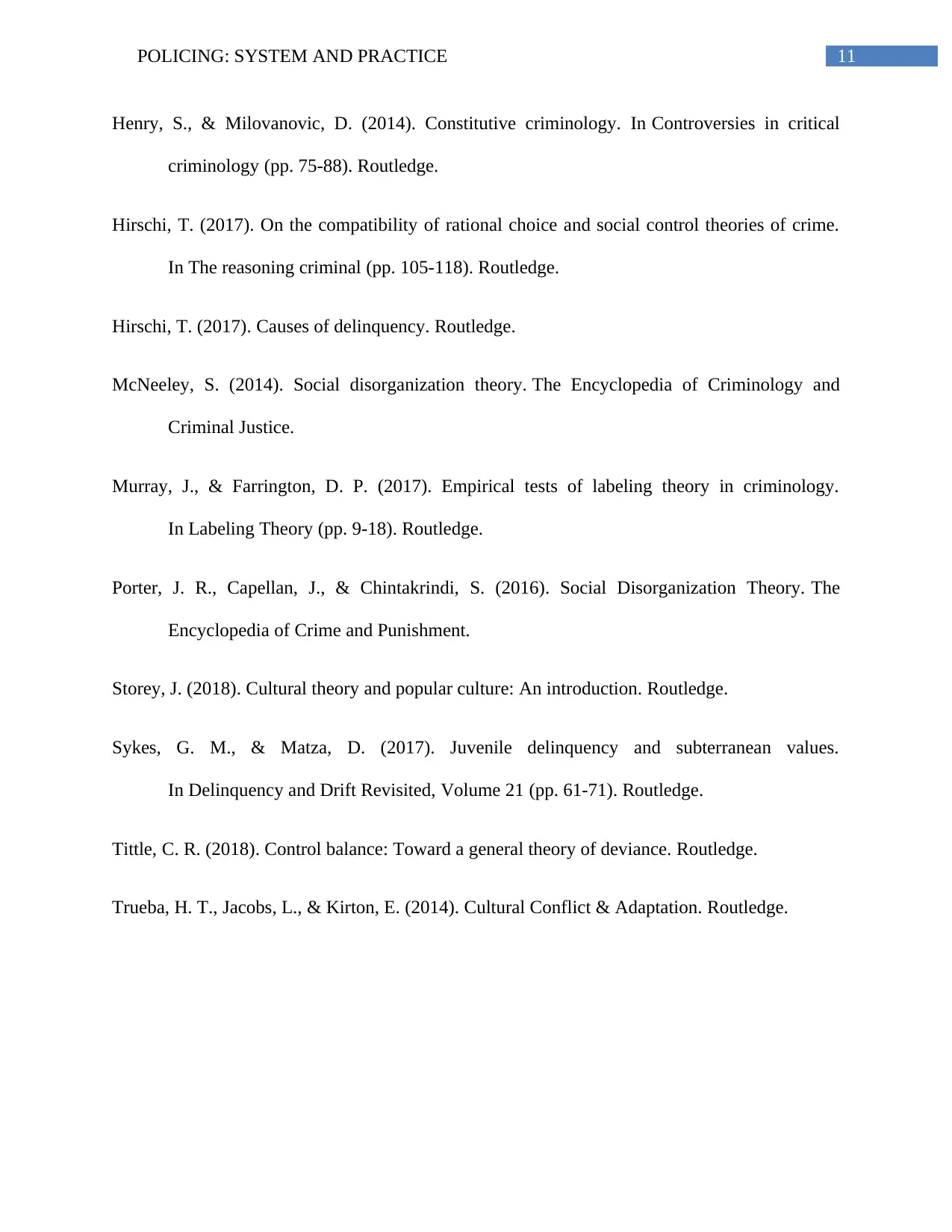
11POLICING: SYSTEM AND PRACTICE
Henry, S., & Milovanovic, D. (2014). Constitutive criminology. In Controversies in critical
criminology (pp. 75-88). Routledge.
Hirschi, T. (2017). On the compatibility of rational choice and social control theories of crime.
In The reasoning criminal (pp. 105-118). Routledge.
Hirschi, T. (2017). Causes of delinquency. Routledge.
McNeeley, S. (2014). Social disorganization theory. The Encyclopedia of Criminology and
Criminal Justice.
Murray, J., & Farrington, D. P. (2017). Empirical tests of labeling theory in criminology.
In Labeling Theory (pp. 9-18). Routledge.
Porter, J. R., Capellan, J., & Chintakrindi, S. (2016). Social Disorganization Theory. The
Encyclopedia of Crime and Punishment.
Storey, J. (2018). Cultural theory and popular culture: An introduction. Routledge.
Sykes, G. M., & Matza, D. (2017). Juvenile delinquency and subterranean values.
In Delinquency and Drift Revisited, Volume 21 (pp. 61-71). Routledge.
Tittle, C. R. (2018). Control balance: Toward a general theory of deviance. Routledge.
Trueba, H. T., Jacobs, L., & Kirton, E. (2014). Cultural Conflict & Adaptation. Routledge.
Henry, S., & Milovanovic, D. (2014). Constitutive criminology. In Controversies in critical
criminology (pp. 75-88). Routledge.
Hirschi, T. (2017). On the compatibility of rational choice and social control theories of crime.
In The reasoning criminal (pp. 105-118). Routledge.
Hirschi, T. (2017). Causes of delinquency. Routledge.
McNeeley, S. (2014). Social disorganization theory. The Encyclopedia of Criminology and
Criminal Justice.
Murray, J., & Farrington, D. P. (2017). Empirical tests of labeling theory in criminology.
In Labeling Theory (pp. 9-18). Routledge.
Porter, J. R., Capellan, J., & Chintakrindi, S. (2016). Social Disorganization Theory. The
Encyclopedia of Crime and Punishment.
Storey, J. (2018). Cultural theory and popular culture: An introduction. Routledge.
Sykes, G. M., & Matza, D. (2017). Juvenile delinquency and subterranean values.
In Delinquency and Drift Revisited, Volume 21 (pp. 61-71). Routledge.
Tittle, C. R. (2018). Control balance: Toward a general theory of deviance. Routledge.
Trueba, H. T., Jacobs, L., & Kirton, E. (2014). Cultural Conflict & Adaptation. Routledge.
⊘ This is a preview!⊘
Do you want full access?
Subscribe today to unlock all pages.

Trusted by 1+ million students worldwide
1 out of 13
Related Documents
Your All-in-One AI-Powered Toolkit for Academic Success.
+13062052269
info@desklib.com
Available 24*7 on WhatsApp / Email
![[object Object]](/_next/static/media/star-bottom.7253800d.svg)
Unlock your academic potential
Copyright © 2020–2025 A2Z Services. All Rights Reserved. Developed and managed by ZUCOL.





